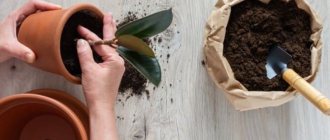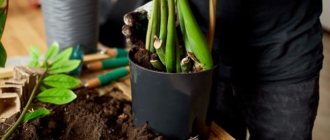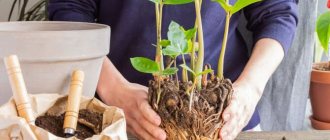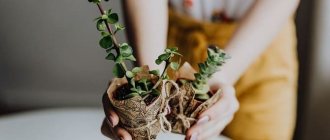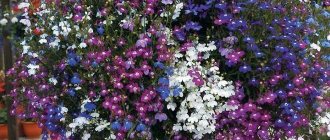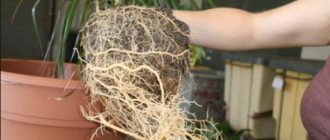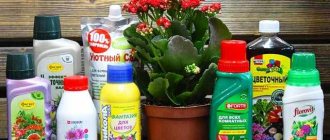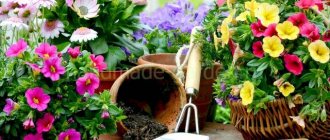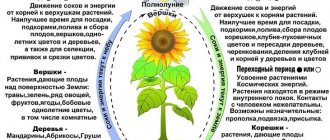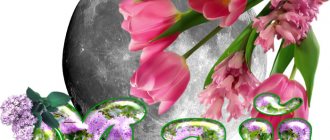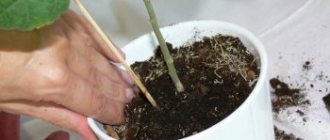“What are the best days to take care of indoor plants?” - This is the question asked by almost every home flower lover. But only some gardeners and flower growers use folk signs, while others use the lunar calendar.
When caring for indoor plants, many are accustomed to relying on the lunar calendar. It helps a person navigate when to feed flowers correctly, when to water or replant them. This ensures their rapid growth, flowering and has a beneficial effect on the life of the plant as a whole.
How to understand that indoor flowers need replanting
In spring and summer, indoor plants require no less attention than garden plants. Increasing daylight hours and warming activate the processes of growth and flowering.
In June, it is advisable to see which flowers need new soil or a larger pot. Many gardeners plan to transplant in June, taking into account the lunar calendar.
Indoor flowers grow in limited spaces. Their soil reserves are small, and nutrients are gradually running out.
Even with timely fertilizing, the soil loses its life-giving properties and becomes unsuitable for most flowers. Transplantation is always stressful. It is important for the florist to make sure that it is necessary. By external signs it is easy to find out whether it is time to replant flowers or not. A transplant is required if:
- Growth slows down. The color of the leaves becomes sickly, poorly saturated with whitish spots. The tips of the shoots begin to dry out.
- The leaves begin to fall off abundantly. The growth of new leaves is slow.
- The overgrown shoots outweigh the pot, which is why it constantly tends to fall.
- The pot is completely occupied by roots, there is practically no soil left. The root system does not fit, and they are trying to crawl out.
- The soil does not absorb moisture well. When watering, water pours out through the drainage holes without staying in the pot.
All these factors indicate the need for an emergency transplant. If you hesitate, the flower may get sick or die.
Transplanting into fresh, fertile soil and into a larger pot will have a beneficial effect on the condition of your green pet. However, ignorance of the rules and inexperience can lead to the development of illness and death.
It is important to remember that different flowers need different growing conditions. Universal rules for transplantation that will help maintain health:
- The flower pot must be washed and, when used again, disinfected with hot water or a weak solution of manganese.
- It is important to form a drainage layer at the bottom of the pot. For this purpose, expanded clay or fine gravel is used.
- It requires plenty of water. A damp ball of earth is easier to remove without damaging the roots.
- It is important to check the condition of the root system. Damaged and rotten areas should be removed with a sharp knife.
- After transplanting, the soil around the central stem must be thoroughly compacted.
By following these simple rules, you can confidently replant your favorite flowers without fear of harming them.
Lunar calendar for replanting indoor plants
♉
JUNE 7, Monday. 26th, 27th lunar day from 02:46. TAURUS
A good time for pest control and any preventive work against diseases. In June the weather is often quite humid
, which can increase the risk of plant diseases.
Gray rot
may appear on raspberry bushes , so as a preventive measure it is worth treating the soil on which the bushes grow
with ash
. Leaves can be treated with special anti-disease compounds.
The day is suitable for planting potatoes
, if you did not have time to do this in the spring.
It is no longer necessary to germinate tubers for these plantings. In addition, during this period the number of diseases and pests affecting potatoes is much smaller. It is worth choosing early varieties
that have time to ripen.
Houseplants
: a good time for any preventive work against plant diseases and pests. Inspect your plants periodically: the sooner you notice an infestation, the faster and easier it will be to eliminate the problem.
Watering
: acceptable. If possible, do not use cold water, especially if the plants are heat-loving. It is acceptable to pour cold water on onions and garlic, but it is better to spray them with a fine spray bottle.
♉♊
JUNE 8, Tuesday. 27th, 28th lunar day from 02:59. TAURUS
,
GEMINI from 21:47
Moon without course from 18:07 to 21:46
Inspect trees and shrubs to spot pests in time. It is better to get rid of curled leaves, insect nests and eggs
etc.
All this is worth collecting and burning. To prevent fungal diseases from appearing on trees, they should be treated with Bordeaux mixture
.
If you had vaccinations in the spring, now is the time to examine them. If the vaccine turned out to be weak and did not take root
, it should be removed, as it can weaken the tree and will be of no use.
The day is suitable for planting root crops
.
For example, it is good to plant onions
next to
carrots:
such a neighborhood will be quite beneficial, because one plant will repel the pests of the other and vice versa.
You can also plant beets and turnips
. Beets planted in early summer will produce good yields by fall and will be suitable for winter storage. If the beets have already been growing since spring, you can now row them so that the sprouts are at least 4 cm apart from each other.
Houseplants
: a good time to loosen the soil in pots, apply fertilizers and control pests.
Watering
: acceptable. Rainwater can be used for irrigation. Tap water must be settled.
© Getty Images
♊
9 , Wednesday. 28th, 29th lunar day from 03:14. GEMINI
Today is a bad day for planting due to the approaching new moon
, but this is a good time to control pests and fertilize the plants in your flower garden. Ventilate greenhouses and greenhouses as a preventive measure against diseases. It is also worth inspecting the plants frequently. With early infection, it is much easier to get rid of the problem.
Houseplants
: at the beginning of summer it is good to move plants from stuffy rooms to fresh air - to balconies or open terraces, if the weather in your area allows. But be more attentive to them in order to notice pests in time. Today is a good time for any preventative work against pests and diseases.
Watering
: It’s better not to water the plants today.
What is better not to do
? engage in any landings (weak Moon); mow lawns; engage in vaccinations.
YOUNG MOON from 13:52
♊
10 , Thursday. 29th, 30th lunar day from 03:36, 1st lunar day at 13:52. GEMINI
NEW MOON at 13:52
ANnular SOLAR ECLIPSE at 13:42 19º♊47´
Moon without course from 20:37
Today is the new moon, so this is not the best time for various things, especially when it comes to planting or pruning, taking cuttings, grafting and many other complex works. It's better to rest today
from gardening and gardening work and spend this day calmly with loved ones, doing simple routine things.
After 14:00
it’s good to make plans for the next month.
Houseplants
: It’s better not to deal with plants today.
Watering
: It’s better not to water the plants today.
What is better not to do
? engage in any landings (weak Moon); mow lawns; engage in grafting and pruning.
© Getty Images Signature
♊♋
JUNE 11, Friday. 1st, 2nd lunar day from 04:07. GEMINI
,
CANCER from 10:22
Moon without course until 10:21
After 10:20, you can start planting greens: different types of salads or arugula, which can withstand temperatures of +6 +8 ° C. Choose those varieties that need to be planted in summer. There are also spring and autumn salads on sale that do not tolerate hot weather. to moisten the soil properly
.
After 10:20 you can go in search of medicinal herbs. Some medicinal plants can also grow in your garden: for example, basil
.
This plant has antiseptic, anti-inflammatory, analgesic and other properties. It helps improve the functioning of the digestive and cardiovascular systems
.
Houseplants
: after 10:20 you can sow greens on the windowsill if you want to grow
salads, dill, parsley, mint, basil
, etc.
Watering
: A good time for watering is after 10:30, when the Moon is in a water sign. If there is a need to water the garden, then it is worth taking into account not only weather conditions, but also the composition of the soil. For example, if the soil is very loose and sandy, it quickly loses moisture, so the plants should be watered more often, but not in too large volumes. If the soil is clayey, then you should water it abundantly, but less often.
What is better not to do
? plant root crops, harvest crops, do home canning; pinch shoots.
♋
JUNE 12, Saturday. 2nd, 3rd lunar day from 04:50. CANCER
This day, just like yesterday, is suitable for planting greenery
different types.
A good day to plant peas
of any variety.
You can also sow cucumbers
in open ground: they will produce a harvest by the end of summer, when those bushes that were planted through seedlings will no longer bear fruit.
Houseplants
: It is permissible to plant greenery on the windowsill.
Read more about planting here: Growing greens at home
Watering
: Regularly water those plants that do not like drought, such as salad vegetables. It is especially useful not to skip watering on days when the Moon moves through a water sign. With a lack of moisture, salads grow bitter.
What is better not to do
? plant root crops, harvest crops, do home canning; pinch shoots.
© Getty Images Pro
♋♌
JUNE 13, Sunday. 3rd, 4th lunar day from 05:48. CANCER
,
LEO from 21:22
Moon without course from 14:16 to 21:21
Today is also a good time to sow greens and salads, but try to complete all work before 14:00. It is good to sow herbs approximately every 10 days
, but especially on the days of the waxing Moon in introductory signs.
For example, the next sowing can be carried out on June 20-23, 2022,
when the Moon is in the water sign of Scorpio.
Dill
seeds can be soaked in hot water (40-50 °C), and then left for another couple of days in water at room temperature.
Houseplants
: It is permissible to plant greenery on the windowsill.
Before planting, it makes sense to soak the seeds, for example, if you are growing parsley
.
Also, in order for greens to grow well, it is necessary to maintain certain temperatures and light conditions, as well as apply fertilizers. But to grow onions
, just place the bulbs in jars of water.
Watering
: good day for watering.
What is better not to do
? plant root crops, harvest crops, do home canning; pinch shoots.
♌
JUNE 14, Monday. 4th, 5th lunar day from 06:58. LION
You can continue planting vegetable crops. It's not too late to plant squash, zucchini, and pumpkin
which
will have time to produce harvests
before the end of the season. Today you can also plant tomatoes, eggplants and late varieties of peppers.
Houseplants
: not all plants benefit from being in direct sunlight, so you should take care of shading on southern and southwestern windows so that the plants do not overheat.
If you have plants that like shade, such as ferns
, keep them on windowsills with minimal light during the day.
Watering
: acceptable, but should not be watered during the daytime in hot weather.
© Getty Images Pro
♌
15 , Tuesday, 5th, 6th lunar day from 08:16. LEO
Moon without course from 20:27
A good day to plant different vegetable crops
in open ground:
cucumbers, pumpkins, zucchini
and other heat-loving plants.
If the planting has already been completed, you can go mushroom
.
Although June is not yet a very rich month for mushrooms, you can already collect champignons, porcini mushrooms, edible fly agarics, russula, June boletus
and others.
Houseplants
: observe the temperature regime for plants such as
azaleas, jasmine, camellia, primrose, saintpaulia, gloxinia
. It is better not to overheat them! Use a sliding shadow on illuminated window sills, for example, it can be created using regular window blinds.
Watering
: acceptable, but should not be watered during the daytime in hot weather.
Favorable days for transplanting flowers in June 2022 according to the lunar calendar
In the spring, all efforts are devoted to cultivating the garden plot. Summer is a good time to take care of indoor flowers.
It is better to start transplanting in June according to the lunar calendar, without waiting for the July heat.
Many flower growers, when replanting pets, rely on the readings of the lunar calendar.
In June 2022, there are many days suitable for working with indoor flowers. The most prosperous numbers are from 11 to 13 and from 18 to 22. These days it is allowed to plant any specimens.
The probability of survival is very high. It is important to consider that different species require certain conditions for their growth. The influence of lunar cycles on them is also different.
- Succulents of all types, including cacti, are best transplanted on June 14 and 15.
- Flowering varieties such as azaleas and orchids can be safely planted on the 12th, 21st and 22nd.
- For decorative deciduous species, June 12 and 18 are optimal.
- Climbing flowers will feel good when transplanted on June 17 and 23.
In accordance with the lunar calendar, each month has days that do not particularly affect plants. Caring for flowers during such periods is possible and will not cause harm. In June 2022, these are June 1 -3, 16, 17, 23, 29 and 30.
The influence of the moon phases on indoor plants in June 2022
Astrology remains an unusual and mysterious science for many people, studying the influence of the starry sky on the life of every person. In the modern world, many books are published annually with calendar calculations by astrologers, covering various professions and activities: hairdressing, housework, business and gardening. The last direction is especially interesting for those who are engaged in landscaping their backyard, growing fruit, berry and vegetable crops, ornamental plants and flowers on the windowsill. But if you don’t have extra time to read detailed information, you can simply read the astrological forecast compiled for the first summer month.
For many years, science has divided the phases of the moon into four phases:
- Full Moon (under the influence of the Full Moon);
- Descending;
- New Moon or New Moon;
- Waxing Crescent.
Each period is important in its own way and is responsible for a certain component of the work. When listening to recommendations, it is important not to violate the basic rules:
1) you should take rest during the New Moon and Full Moon periods, so as not to harm your pets. If you believe the experience of experienced gardeners, any manipulations with plants during this period will not be beneficial. Any of the two phases makes flowers vulnerable to the perception of the work carried out. In the best case, the growing season will slow down and after a short time the stress will subside. In the worst case, the plant will get sick and die;
2) during the period of the waning Moon, transplanting into large pots and changing the soil for plants and flowers with filamentous roots are allowed, but not recommended. Work with tuberous and bulbous flowers is welcome: lily, cyclamen, hyacinth, gloriosis, hippeastrum, clivia, crinum, zephyranthes, hemanthus, wallota, amaryllis, gloxinia, ever-flowering begonia, amorphophallios and others. Caring for climbing vines and plants, succulents and cacti is allowed;
3) during the New Moon phase, several days “before” and “after”, it is not recommended to devote time to the home garden; it is better to devote your free hours to watching your favorite TV series or reading fiction. If necessary, you can treat the crown and soil for prevention against diseases and pests, remove weeds and collect discarded leaves. An alternative work would be: going to the garden store for bowls, fertilizer or new soil, wiping pots and trays from dust. If possible, you can clean off plaque formed unknowingly from watering with running water;
4) the most favorable time for carrying out any work remains the waxing Moon. During the period of her patronage, you can pay special attention to root and root feeding. If necessary, in June you can transplant some plants into large bowls by changing the soil. Ready for transplantation in June:
- adenium;
- orchid (phalaenopsis, lady's slipper, singolo and brassia);
- anthurium;
- guzmanim;
- Krasula;
- laurel;
- Ficus Elastica or Microcarpa Jinseng;
- gardenia;
- Sansevieria;
- Kalanchoe;
- aspidistr;
- lemon and orange tree;
- Zamioculcas;
- dracaena (any variety);
- Fatsia Japonica;
- chamedorea elegans;
- date fruit;
- caladium;
- monstera;
- spathiphyllum;
- croton;
- dieffenbachia;
- spurge;
- Crassula (money tree).
Important!
You can replant any indoor plants after flowering that need a change in soil or an increase in growth capacity. It is not recommended to pick or plant flowers that are blooming or producing buds. By breaking the rule, the distribution of juice can be blunted, drying out the peduncle and causing disease, including rotting of the roots and darkening of the tips of the leaves.
Lunar calendar of flower transplantation by day for June 2022, table
For convenience and effective planting of flowers, you can use the table.
| Favorability | Type of flower crop | Period in June |
| Favorable days (reproduction by leaves, shoots, seeds) | short | 11-13, 18-22 |
| curly | 17,23 | |
| succulents | 14, 15 | |
| Favorable days (propagation by bulbs, tubers, rhizomes) | stocky | 2, 3, 6-8, 25,26,29,30 |
| drought-resistant | 4,5 | |
| curly | 9 | |
| Neutral days | The phases of the moon do not affect the development of the plant in any way. | 16,17,23 |
| unfavorable | For all types of plants | 1,10,24,27,28 |
How moon signs affect flowers when transplanting
Since ancient times, people have noticed that planting flowers in certain phases of the moon leads to good rooting and abundant flowering. The periods of passage of different constellations by the night luminary are also important. Proponents of astrology listen to three main ways to determine favorable days according to the lunar calendar:
- Taking into account the phase of the moon. The waxing and waning moon, new moon, and full moon have a special effect on the well-being of flowers when planting.
- A traditional method that determines the days of passage of the night star through certain constellations.
- Identification of days in the lunar cycle that are responsible for the good development of roots, fruits, inflorescences, and greenery.
If you want to plant flowers according to your zodiac signs, you need to consider the following information:
- Moon in Aquarius – infertility (June 1, 27, 28). Planting flowers is not recommended.
- Moon in Gemini (June 9, 10), Sagittarius (June 23, 24), Virgo (June 16, 17) – low fertility.
- Moon in Libra (June 18, 19, 20) and Capricorn (June 25, 26). The signs are considered quite fertile. Transplantation is possible.
- The Moon in Cancer (June 11, 12, 13), Taurus (June 6, 7, 8), Pisces (June 2, 3, 29, 30) and Scorpio (June 21, 22) indicates the most favorable time for transplantation.
Moon phases and their influence on favorable days
Each of the four periods of the lunar cycle has a special effect on plants:
- The new moon is one of the most negative periods for transplantation. At this time, the plant loses vital energy and may even die after a traumatic operation.
- The waxing moon is the time when the sap of a plant accumulates in its green part. This period is most favorable for working with indoor flowers, which are propagated by cuttings and layering.
- The full moon is an unfavorable time for transplantation. To avoid negative consequences for plants, it is not advisable to touch them at this time.
- The waning moon is the period when juices go to the roots of plants. At this time, it is good to replant flowers that reproduce using bulbs or rhizomes.
Signs associated with flower transplantation
People in the modern world are fond of mysticism and mythology. Flowers were no exception and over the long history of civilization they have acquired interesting and sometimes useful signs. Many of them are carefully passed down from generation to generation.
- It is better to replant on the so-called “women’s days”: Wednesday, Friday, Saturday, Sunday. Then the survival rate is better and growth is more active.
- It is not recommended to transplant in a bad mood.
- “If you plant it in the mud, you will be a prince” - a Russian proverb that accurately determines in what soil a flower should be planted. The more moist the soil, the easier it will be to adapt and develop new roots.
Is it possible to replant indoor plants on church holidays?
If there is free time during religious holidays, then flower transplantation is possible. However, we must remember that many Christian holidays occur in spring and early summer. As the seasons change, agricultural work also changes. It is believed that replanting should not be done on the following holiday dates in 2022:
- Meeting - February 15.
- Annunciation - April 7.
- Easter of Christ - May 2.
- Ascension of the Lord - June 10.
- Transfiguration – August 19.
- Dormition - August 28.
- Nativity of the Virgin Mary - September 21.
- Exaltation of the Holy Cross - September 27.
Orthodox holidays encourage people not to think about pressing matters, but to devote time to communicating with God and fellow believers. Then the year will be blessed with abundant flowering and harvest.
Tips for caring for flowers in June 2022
Caring for house flowers in June should meet their needs. At the beginning of summer, flowers actively develop, increase their green mass and lay buds. For their favorable growth, it is necessary to provide three important life factors:
- Lighting.
- Watering
- Temperature regime.
In addition to vital conditions, the quality and composition of the soil plays an important role.
Basic care in June is:
- Sufficient and timely watering and irrigation.
- Pruning excess and diseased shoots and faded flower stalks.
- Transfer to more comfortable conditions.
- Shading from direct sunlight to protect against burns.
- Moderate fertilizing with complex fertilizers.
All the efforts made in June will pay off in the cold winter with pleasing to the eye, healthy home flowers.
Flower growers' work in June
In June, many plants have just begun to bloom or are preparing to open buds. Therefore, they need to be provided with special care. Also this month it is necessary to carry out treatment against pests and diseases, and engage in reproduction.
Top dressing
In June it is necessary to fertilize. For those plants that have already begun to bloom or are actively preparing to bloom buds, mineral mixtures with a high potassium content are needed. Those bushes that grow green mass should continue to be fed with fertilizers with a sufficient amount of nitrogen, but do not overdo it, so as not to be left without flowers.
Treatment against diseases and pests
At the first signs of pests or diseases, treat with fungicides or insecticides:
- with powdery mildew and spotting, Skor (2-5 ml per 10 liters of water) and pure flower (2-4 mm per 5 liters) help;
- Maxim Dachnik is effective against fusarium wilt (2 ml per 1 liter, solution consumption 50-100 ml per root);
- against various insects, plants need to be treated with Fufanon-Nova, Altara;
- Among biological agents against ticks, thrips and aphids, it is recommended to use Fitoverm.
Attention! The sooner pests and signs of disease on plants are detected, the easier it is to get rid of them. Therefore, it is advisable to inspect plants daily.
Digging and planting bulbs
You can already begin to dig up those bulbous plants that have already bloomed, begun to turn yellow and wither. If you are late with this, you may not find their rhizomes, accidentally chop them with a shovel, and leave the daughter parts in the ground.
My crocuses in April. Photo from Mister Summer Resident
Helpful information! In order not to accidentally leave the bulbs in the ground, it is recommended to pre-plant them in containers and bury them only in this form. After flowering has finished, the box will just need to be dug up. Thanks to this, not a single bulb will get lost. Plant summer flowers in the vacant space.
In exceptional cases, bulbous plants may not be dug up. When the stems are completely dry, they can be pulled out (the bulb will not be damaged).
But it is still recommended to dig up valuable varieties.
You can plant autumn-blooming bulbs in early June. For example: gladioli. Read on our website which bulbous flowers should be dug up and when, and which ones should be planted in the spring.
Division of irises
Immediately after flowering, divide and plant the iris bushes. June is the most favorable time for this: the plants rest, and then begin to actively grow the root system and greenery.
During division and replanting, you need to inspect the roots. Destroy the sick, heal the damaged. The annual link is best suited for further planting. He needs to shorten the leaves (cutting them diagonally) and trim the roots.
Feed bushes that do not need planting with nutrient mixtures with phosphorus and potassium. Remove flower stalks from overgrown clumps.
Read more about irises here.
Caring for gladioli
In these first summer months, when gladioli are just beginning to gain strength, it is worth paying attention to them. Loosen and water (unless the weather is rainy) weekly. When the second leaf appears, fertilize with ammonium nitrate, and when the fourth leaf appears, fertilize with nitrogen and potassium fertilizer, spray with a solution of boric acid (2 g per 10 liters of water).
Read more about gladioli on our website.
Cuttings of roses
Cuttings from the middle part of a flowering shoot that are not affected by insects and infections are best suited for propagation. On planting material with 2-3 leaves, leave only one top leaf and soak in Kornevin according to the instructions.
For the cuttings, you need to set aside a bright place, but protected from direct sunlight.
Further step-by-step instructions:
- Prepare the soil mixture. The soil should be fertile and structural, for example, garden soil or turf, sand, compost in a ratio of 3 to 2 to 1.
- Treat and level the area reserved for the cuttings.
- Spread the prepared soil mixture in a layer of 10-15 cm.
- Pour 3 cm of sand on top.
- Before planting the cuttings, water the soil with a solution of potassium permanganate (1 g per 10 liters of water).
- Plant the planting material at an angle so that only one bud remains on top.
- Build a frame and cover it with film on top.
Important! The cover can be removed only after rooting and the appearance of the first greenery.
Read more about different ways of growing roses from cuttings on our website.
Sowing biennials
Medium bell
In June you can sow:
Daisies
- middle bell;
- Turkish cloves;
- daisies;
- pansies.
Turkish cloves
Place the seeds shallow in the soil. Mulch the top with grass or cover with non-woven material to maintain soil moisture.
Pansies
After the seeds germinate, if the planting is too dense, row the rows. Do not throw away the sprouts, but transplant them to a new place.
For reference! In September, the strengthened flowers will need to be dug up and moved to a new place, where they will bloom next season.
Caring for lilies
Lilies have a deep root system, so they need abundant but infrequent watering. It is necessary to apply fertilizing in the form of an organic infusion or complex mixtures. Mulch the soil so that it does not overheat and retains moisture.
Lilies
It is recommended to plant annuals in the foreground. When the lilies fade, they will decorate the area. When cutting buds for bouquets, you need to leave at least 2/3 of the stem, otherwise the bulbs will weaken.
Read more about lilies and their varieties.
Caring for indoor plants
Pelargonium
Coleus
Take the following out of the rooms into the fresh air (balcony, loggia):
- pelargonium;
- coleus;
- ficus;
- hibiscus;
- Crassula;
- poinsettia;
- zephyranthes, etc.
All plants must be shaded from direct sunlight. If possible, coleus and pelargonium can be planted in flower beds in the fresh air, cutting cuttings for rooting. On the street, even heavily overgrown bushes will return their decorative effect.
Tips for planting pelargonium
The bulbs of faded hippeastrums need to be taken out to an open area in the shade to ripen. It is not necessary to replant them; it is enough to place them outside in pots, replacing the top layer of soil. Don't forget to feed regularly. Bulbs ripen better in the fresh air.
In summer and autumn they can be sent “to rest”, and in winter you can see lush flowering at home.
Hippeastrum
Compliance with the recommendations given in the Lunar calendar helps to achieve good development and lush flowering of ornamental plants. To make sure of this, you just need to try to follow these rules, especially since they are not at all complicated.
How to care for flowers after transplantation
After transplantation, you should carefully monitor the condition of your green pet. The flower pot should not be exposed to the open sun. It is better to leave it in partial shade for a while.
IT IS INTERESTING that you should not place a young, newly planted flower next to adult specimens. Watering should be carried out depending on the needs of the flower crop. For example, it is not recommended to water succulents for a week after planting, but geraniums, on the contrary, are watered regularly and abundantly.
After the transplanted flowers begin to develop young shoots and leaves, we can conclude that they have taken root.
What is a lunar calendar and how to use it
The lunar calendar is a unique and simple guide to growing and replanting indoor plants. With its help, you can easily find the most suitable time to care for your favorite flowers. The moon has a gravitational effect on the moisture of the soil and plants, therefore, by choosing a suitable date for replanting flowers, you can be sure that they will not only take root in the new place, but will also grow strong and give good flowering in the future.
Common mistakes
Transplanting home flowers seems like a simple matter . However, some mistakes can lead to weakening of the plant and even its death.
- Using old soil will not provide the flower with the necessary nutrients.
- Soil that is not disinfected in advance can cause infectious and parasitic diseases.
- The remaining earthen clod on the roots makes it difficult to assess their condition.
- Unremoved diseased and rotten roots can lead to the death of the crop.
- Deepening during planting leads to inhibition of growth and flowering.
- Insufficiently moistened soil contains air pockets, which harms the roots.
By avoiding such mistakes, you can quickly and efficiently replant your favorite home flowers without fear for their future fate.
Answers to frequently asked questions
Questions that gardeners have during transplantation:
How often do flowers need to be replanted?
Replanted approximately every three years. Each case requires an individual approach.
Is it necessary to completely clear the roots from the old soil?
Yes, it is recommended to completely clean the roots from the soil and carefully inspect them for damage. Remove damaged areas.
When is it better to carry out the procedure: in the morning or in the evening?
Popular wisdom says that you should not replant a plant in the evening. However, it is evening planting that allows the flower to gain strength.
How often should flowers be watered after transplanting?
Watering depends on the type of flower crop. When transplanting a specific flower, you should take into account its preferences for water and light.
